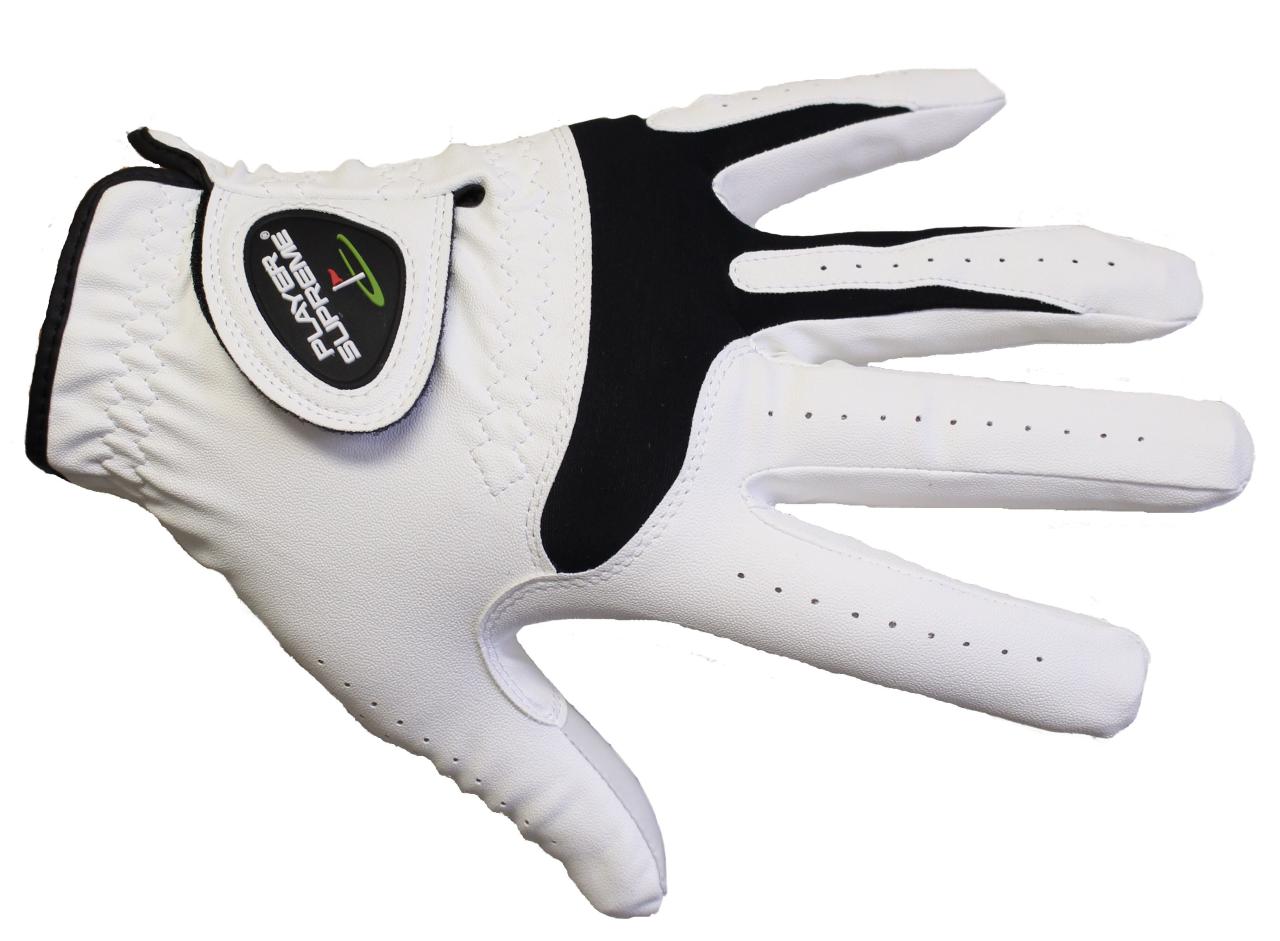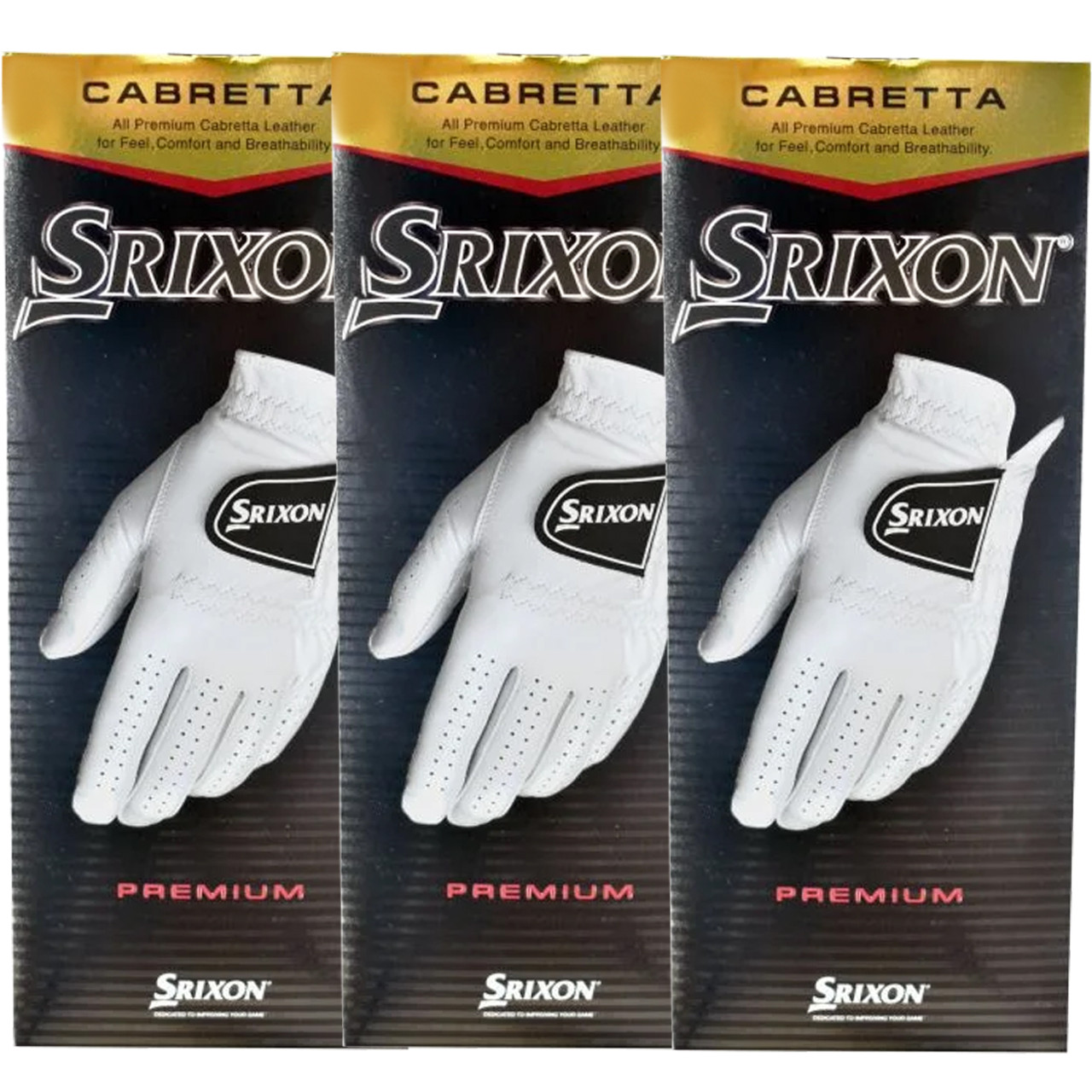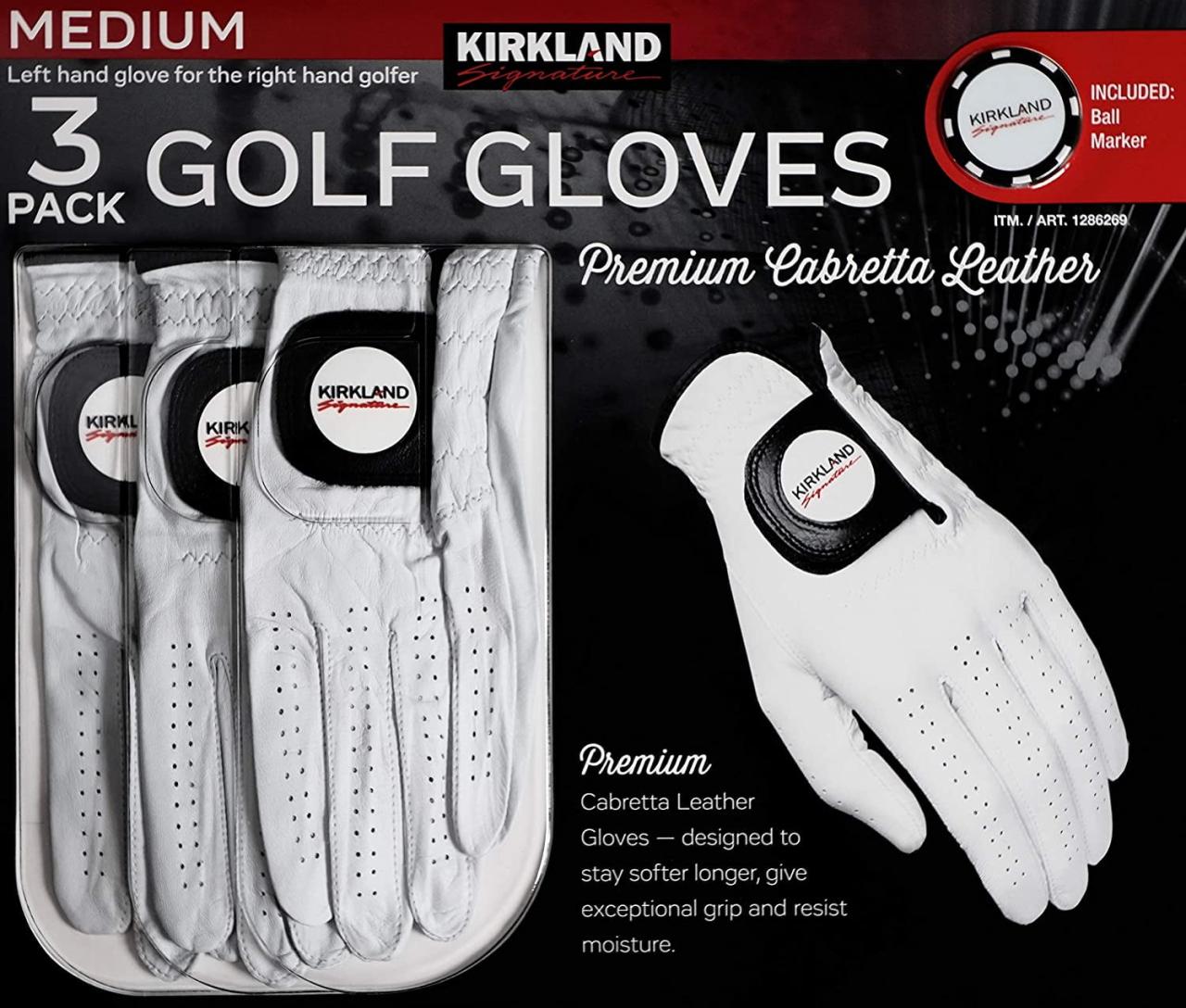Leather golf gloves, a staple in the golfer’s arsenal, have evolved from a simple tool to an essential component for optimal performance. From the history of their use to the meticulous craftsmanship of modern designs, these gloves offer a unique blend of comfort, grip, and control that elevates the game.
The evolution of leather golf gloves has mirrored the advancements in golf technology, with each era leaving its mark on the design and materials used. Today, golfers have access to a diverse range of leather types, construction techniques, and styles to suit their individual preferences and playing styles.
Whether you’re a seasoned pro or a weekend warrior, understanding the nuances of leather golf gloves can significantly impact your game.
Introduction to Leather Golf Gloves

Leather golf gloves are essential accessories for golfers of all skill levels, providing enhanced grip, comfort, and protection. These gloves are designed to improve a golfer’s performance by enhancing their ability to control the club, particularly during swings.
History and Evolution of Leather Golf Gloves
Leather golf gloves have a rich history, dating back to the early days of the sport. The earliest gloves were simple leather coverings that offered basic protection and grip. Over time, these gloves evolved to incorporate features such as padding, ventilation, and specialized designs for different hand sizes and grip styles.
- Early Golf Gloves:Early golf gloves were primarily made from thick leather, providing basic protection and grip. They were often simple designs, with little or no padding or ventilation.
- Introduction of Padding and Ventilation:As the sport evolved, golf gloves began incorporating padding to enhance comfort and reduce hand fatigue. Ventilation features were also introduced to improve breathability and reduce perspiration.
- Specialized Designs:In the modern era, leather golf gloves are available in a wide range of designs, catering to different hand sizes, grip styles, and playing conditions. These gloves feature advanced materials, construction techniques, and ergonomic designs for optimal performance.
Materials and Construction Techniques
Leather golf gloves are primarily made from high-quality leather, which offers exceptional durability, grip, and breathability. The type of leather used can vary depending on the brand and the glove’s intended purpose.
- Leather Types:Common leather types used in golf gloves include cabretta leather, sheepskin leather, and goatskin leather. Cabretta leather is known for its softness, durability, and excellent grip, making it a popular choice for premium golf gloves. Sheepskin leather offers a balance of softness and durability, while goatskin leather is a more affordable option with good grip properties.
- Construction Techniques:The construction of leather golf gloves involves precise stitching and reinforcement techniques to ensure durability and comfort. Gloves are typically made with multiple panels of leather, strategically sewn together to create a seamless and comfortable fit. Padding is often added to the palm and fingers for added protection and grip.
Types of Leather Golf Gloves
Leather golf gloves are essential for golfers of all skill levels, providing a comfortable and secure grip on the club. They come in a variety of styles and materials, each offering unique advantages and disadvantages. Understanding the different types of leather golf gloves can help golfers choose the best option for their needs.
Types of Leather Golf Gloves
Leather golf gloves are generally categorized based on the length of their fingers.
- Full-Finger Golf Gloves: These gloves provide the most coverage and protection, covering the entire hand and fingers. They are ideal for golfers who want maximum grip and control, especially in cold or wet weather. Full-finger gloves are also beneficial for golfers with sensitive skin or who are prone to blisters.
- Half-Finger Golf Gloves: These gloves cover the hand and fingers up to the first knuckle. They offer good grip and control while allowing for more flexibility and dexterity. Half-finger gloves are a popular choice for golfers who prefer a more breathable option and want to feel the club more directly.
- Fingerless Golf Gloves: These gloves cover the hand and wrist but leave the fingers exposed. They provide minimal grip and protection, but they are very breathable and allow for maximum flexibility. Fingerless gloves are often used in warm weather or by golfers who prefer a less restrictive feel.
Types of Leather, Leather golf gloves
The type of leather used in golf gloves can significantly affect their performance and feel.
- Cabretta Leather: This type of leather is made from the skin of a young goat. It is known for its soft texture, excellent grip, and durability. Cabretta leather is a popular choice for high-end golf gloves, but it can be more expensive than other types of leather.
- Kangaroo Leather: This type of leather is made from the skin of a kangaroo. It is known for its strength, durability, and flexibility. Kangaroo leather is often used in golf gloves that are designed for extreme conditions, such as hot or humid weather.
- Sheepskin Leather: This type of leather is made from the skin of a sheep. It is known for its softness, breathability, and affordability. Sheepskin leather is often used in golf gloves that are designed for comfort and breathability.
Choosing the Right Leather Golf Glove

A good leather golf glove is essential for a comfortable and consistent grip, improving your overall game. Selecting the right glove involves considering various factors, including size, fit, and grip type.
Size and Fit
Choosing the right size is crucial for a comfortable and effective grip. A glove that is too tight will restrict your hand movement and cause discomfort, while a loose glove will slide around and affect your grip.To determine your size, measure the circumference of your dominant hand, excluding your thumb, at the widest part.
You can use a measuring tape or a piece of string.
- Consult a size chart provided by the glove manufacturer to find the corresponding size for your measurement. Most manufacturers offer a range of sizes, typically from small to extra-large.
- Try on different sizes before making a purchase. You should be able to comfortably fit your hand into the glove, with no tightness or looseness. The glove should feel snug but not constricting.
- When you make a fist, your fingers should be able to move freely, and the glove should not bunch up or feel too loose.
Grip Type
Leather golf gloves come in different grip types, each designed to provide a specific level of grip and feel.
- Cabretta Leather:Known for its soft, supple texture, Cabretta leather offers a premium feel and excellent grip. It is the most popular type of leather used in golf gloves.
- Kangaroo Leather:Offers a similar feel to Cabretta leather but is even thinner and more flexible. It is often preferred by players who prefer a lighter glove with a more sensitive feel.
- Synthetic Leather:A more affordable alternative to leather, synthetic leather provides a durable and comfortable grip. It is a good option for beginners or players who are on a budget.
Hand Size and Playing Style
Your hand size and playing style also play a role in choosing the right glove.
- Hand Size:Players with smaller hands may prefer a glove with a tighter fit, while players with larger hands may need a glove with a looser fit. The glove should fit comfortably and allow for full range of motion.
- Playing Style:If you are a power hitter, you may prefer a glove with a more durable grip, while if you are a finesse player, you may prefer a glove with a softer feel.
Breaking In New Leather Golf Gloves
New leather gloves can feel stiff and uncomfortable at first. Breaking them in will help them mold to your hand and provide a more comfortable fit.
- Wear the glove for short periods:Start by wearing the glove for a few minutes at a time, gradually increasing the duration as the leather softens.
- Use a glove conditioner:Applying a leather conditioner can help to soften the leather and make it more pliable. Follow the manufacturer’s instructions for application.
- Moisturize your hands:Keeping your hands moisturized will help to prevent the leather from drying out and becoming stiff.
Care and Maintenance of Leather Golf Gloves

Leather golf gloves are an investment, and proper care can significantly extend their lifespan. By following a few simple steps, you can keep your gloves looking and feeling their best, ensuring optimal performance on the course.
Cleaning Leather Golf Gloves
Leather golf gloves can become soiled with dirt, sweat, and grime over time. Regular cleaning helps maintain their appearance and prevents damage.
- Use a damp cloth to wipe away any visible dirt or stains. Avoid using harsh chemicals or detergents, as these can damage the leather.
- For more stubborn stains, a mild leather cleaner can be used. Apply the cleaner sparingly and follow the instructions on the product label.
- Allow the gloves to air dry completely after cleaning. Avoid direct sunlight or heat sources, as these can cause the leather to crack or fade.
Drying Leather Golf Gloves
Moisture can damage leather, leading to mildew and a stiff, uncomfortable feel. Proper drying is essential for maintaining the quality of your gloves.
- If your gloves get wet, allow them to air dry naturally at room temperature. Avoid using a hairdryer or other heat sources, as these can damage the leather.
- To speed up the drying process, you can stuff the gloves with newspaper or a towel to absorb moisture. Change the paper or towel as needed until the gloves are completely dry.
- Avoid storing wet gloves, as this can lead to mold and mildew growth. Always ensure your gloves are completely dry before storing them.
Preventing Damage and Extending Lifespan
Leather golf gloves are susceptible to damage from various factors. Taking preventative measures can help extend their lifespan and keep them in optimal condition.
- Avoid wearing gloves in extreme weather conditions, such as extreme heat or cold. High temperatures can cause the leather to crack, while freezing temperatures can make it brittle.
- Store gloves in a cool, dry place away from direct sunlight and heat sources. A glove box or drawer is an ideal storage solution.
- Avoid storing gloves in a damp or humid environment, as this can lead to mildew growth.
- Rotate your gloves regularly to prevent excessive wear on a single pair.
Storing Leather Golf Gloves
Proper storage is crucial for maintaining the quality and lifespan of your leather golf gloves.
- Store gloves in a cool, dry place away from direct sunlight and heat sources. A glove box or drawer is an ideal storage solution.
- Avoid storing gloves in a damp or humid environment, as this can lead to mildew growth.
- If you are storing gloves for an extended period, consider using a cedar wood block or a sachet of silica gel to absorb moisture and prevent mildew.
Leather Golf Gloves and Performance
Leather golf gloves play a pivotal role in enhancing a golfer’s performance by providing a secure grip, improving club control, and reducing hand fatigue. The tactile nature of leather allows for a natural feel, enhancing shot accuracy and overall game play.
Impact on Grip Strength and Club Control
Leather golf gloves provide a superior grip, which translates to greater control over the club. The textured surface of leather creates friction, preventing the club from slipping during the swing. This enhanced grip strength enables golfers to generate more power and accuracy with their shots.
“Leather golf gloves give me the confidence to swing harder knowing the club won’t slip. It’s a subtle difference, but it makes a big impact on my game.”
Tiger Woods, Professional Golfer
Comfort and Reduced Hand Fatigue
Leather golf gloves are known for their comfort and breathability. The soft, supple nature of leather conforms to the shape of the hand, providing a snug fit that minimizes pressure points and discomfort. This comfort is particularly important during long rounds of golf, where hand fatigue can significantly affect performance.
“I’ve always preferred leather gloves because they feel so natural on my hands. They don’t get stiff or uncomfortable even after hours on the course.”
Rory McIlroy, Professional Golfer
Frequently Asked Questions
How often should I replace my leather golf gloves?
Leather golf gloves should be replaced when they become worn, stretched, or lose their grip. This typically happens after 10-20 rounds of golf, depending on the quality of the glove and how often it’s used.
Can I wash my leather golf gloves?
It’s generally not recommended to wash leather golf gloves. They can be cleaned with a damp cloth and mild soap, but excessive washing can damage the leather.
What’s the difference between cabretta and kangaroo leather gloves?
Cabretta leather is known for its soft feel and excellent grip, while kangaroo leather is known for its durability and thinness. Cabretta gloves are often preferred by players who prioritize feel, while kangaroo gloves are preferred by players who prioritize durability.

